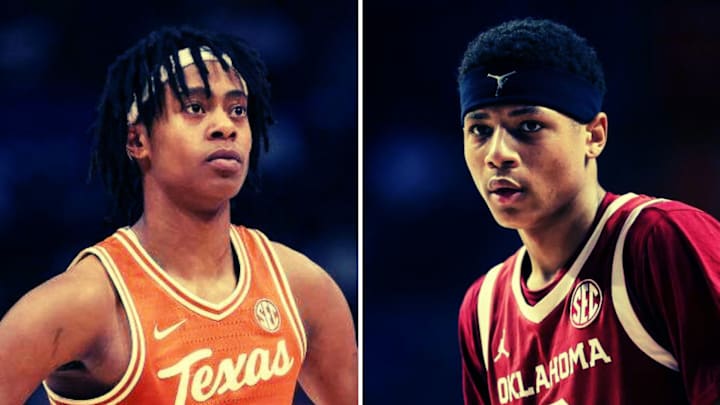The first pick of the 2025 NBA Draft seems to be settled. It would be an utter shock if the Dallas Mavericks selected anyone other than Duke forward Cooper Flagg with the No. 1 overall pick and, while trade rumblings could affect the No. 2 selection, the assumption that Rutgers guard Dylan Harper will be the No. 2 pick is in the ether. After that, however, uncertainty reigns, and that is due to a combination of team needs/preferences and also the general lack of consensus on the tier of prospects after Flagg and Harper.
One such disagreement making the rounds is between Texas guard Tre Johnson and Oklahoma guard Jeremiah Fears. Both are "one and done" players from prominent college basketball teams, and there are several teams in the high-to-mid lottery that could at least be in the market for an infusion of backcourt talent. Mock drafts lay out a split between the two and, quite frankly, they are very different archetypes. In this space, we'll discuss those differences and the case for each player.
First, the skill set differences are rather stark when watching Johnson and Fears. While it isn't necessarily this clean, Johnson profiles as a primary shooting guard, while Fears leans more to an on-ball creator in a point/lead guard mold. Another split comes from the shooting difference between the players, with shooting as perhaps the No. 1 appeal for Johnson, whereas Fears struggled to convert perimeter attempts at the college level. Overall size concerns are present for Fears, whereas Johnson essentially enters the draft with prototypical measureables for a player at the shooting guard spot. These differences can be helpful in delineating the prospects, even if they will inevitably be compared throughout the process.
The case for Tre Johnson in the NBA Draft
Tre Johnson is, in some ways, the prototypical shooting guard prospect, almost in throwback fashion. He stands at 6-foot-5 without shoes to go along with a 6-foot-10 wingspan, and Johnson's scoring prowess was clear at Texas. He averaged 19.9 points per game in his one collegiate campaign, and Johnson is one of the best shooters in the class.
He converted 39.7 percent of his 3-point attempts and 87.1 percent of his free throw attempts at Texas, illustrating his shooting upside, and Johnson gets to those shots in a variety of ways. He can fly off screens, he can shoot pull-ups, and Johnson is dynamic as a perimeter threat in transition. While Johnson may have challenges putting the ball on the floor and beating defenders at the NBA level, he is already a proven shot maker at the highest levels.
Johnson does take questionable shots that could keep his efficiency down, and he doesn't put a ton of pressure on the rim. Part of that is that Johnson is an okay, but not tremendous, athlete by positional standards, and that could also limit his defensive impact, even if the measureables should be helpful.
The case for Jeremiah Fears in the NBA Draft
While smaller guards are not currently in vogue, Fears has clearly defined strengths that make him a highly intriguing upside bet at the NBA level. He stands at 6-foot-2 with a 6-foot-5 wingspan and, despite a relatively slender frame at 180 pounds, Fears can dole out punishment on drives. He averaged 17.1 points and 4.1 assists per game at Oklahoma, serving as the lead initiator for the Sooners, and any profile of Fears is headlined by his handle and quickness.
Simply put, Fears has an uber-elite handle and the ability to utilize it alongside his speed to break the paint. That causes opposing defenses to react to him, instead of the opposite, and Fears also has a penchant for drawing fouls and creating free throw attempts that will be valuable in the NBA. He also projects as at least a potential three-level scorer, with a strong mid-range framework.
On the flip side, Fears does have a glaring question mark with his shooting efficiency. It helps that Fears was an 85 percent free throw shooter in college, but he converted only 28.4 percent of his 3-point attempts and also had some troubling finishing at Oklahoma. Fears is also not an elite passer, especially for a small guard, and his defense could be worrisome simply given his size.
The verdict: Tre Johnson has a more obvious NBA role
Both players have clear high-end upside if things break right. As noted repeatedly, they are different archetypes so it can be difficult to directly compare, but a slight lean to Johnson may be justified, simply because of where the league is going. The bar is incredibly high at this juncture for players of Fears' size to reach star-level outcomes. Clearly, it is not impossible, but the league is trending to more size and strength on the perimeter, and players like Trae Young and Darius Garland are more outliers than players who fit within the status quo.
Ultimately, Johnson would be a touch higher on a big board in a vacuum, particularly if one buys his ability to at least hold up reasonably well on defense and perhaps trim some of the fat out of his shot selection. All in all, Johnson and Fears are both clear lottery picks in this class, but as with any non-transcendent rookie, uncertainty can be often be understated.
